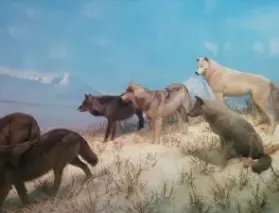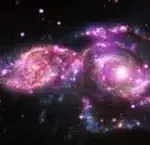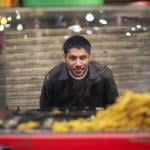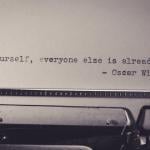 (I was looking back over the articles I’ve published on SNS during the past six year and was surprised to find that this will be the 50th.)
(I was looking back over the articles I’ve published on SNS during the past six year and was surprised to find that this will be the 50th.)
The One and the Many
I don’t know how literature is taught in schools today, but when I was young, we were instructed to find the theme of a literary work. The theme was the single idea that held together the work’s diverse elements. So, for instance, one might propose that the theme of Wallace Steven’s poem, “The Emperor of Ice Cream,” is the ephemerality of life – life compared metaphorically to ice cream melting in the heat of the summer’s sun. The idea of art having a unifying theme goes back at least to Aristotle, who stated that beautiful objects possess unity in variety.
The progress of science can be viewed as something like finding “the theme” of Nature. Thus in gravity, Isaac Newton discovered the theme which unifies such diverse phenomena as apples falling to the ground, balloons rising in the sky and the moon orbiting the earth. Maxwell and Faraday found a theme which unified magnetism, electricity and light, and called it electromagnetic energy. Darwin revealed a theme that unified the great diversity of life forms throughout the world, the theme of evolution by natural selection. Einstein found a theme that unified matter and energy, and also one that unified space and time. Currently, physicists seek the theme that can unify quantum mechanics and general relativity – the so-called theory of everything.
Prior to the rise of science, the idea of God served as the theory of everything. Whether the grand unifications of science replace the idea of God or expand it is a matter of semantics. In either case, there is something to be said for having a distinctive word, such as God or Tao or Nature, that signifies the unified source and ultimate context of the phenomenal diversity of the world.
There are other phenomena besides art works and scientific theories that can be explored under the idea of unity in diversity. A well functioning organization or organism brings a diverse collection of individual elements into a unified purpose. A goal or a plan collects diverse efforts over a period of time towards a common result. As a musical theme brings harmony to a diverse collection of notes, so an organization brings harmony to the activities of its members or a plan provides harmoniousness to our activities
Center and Periphery
Spirituality (as I use that word) also seeks unity in diversity, but of a different kind. By nature, we are a hodgepodge of contents — thoughts, feelings, perceptions, images, appetites, etc. These comprise what in the Eastern meditation traditions is aptly called “the monkey mind.” Through spiritual discipline we collect and harmonize our mind. This can take the form either of a quieting of consciousness or of sustained and focused thought (I call the first of these meditation and the second contemplation).
Personally, I prefer to use the word “center” rather than “unity”, when applied to something like meditation or contemplation. “Unity” or “oneness” suggest quantities, but spiritual experience is a quality rather than a quantity – the quality of being centered. From the center of our being we can experience the world’s multiplicity as a harmony, whereas off-center, it is the conflictedness of the world’s diverse parts that seems most pronounced.
Either/Or and Both/And
I do not think it an exaggeration to say that our culture tends to think in “either/or” terms. The divisiveness of modern culture has been much remarked upon of late, and I think this divisiveness often stems from this either/or mentality.
As an example, on political and social issues we have on one side people who tend to value individual rights, the economy, tradition and religion and on the other, people who value the needs of the community, the environment, progress and tolerance. It seems rather obvious to me that both sets of terms represent things that are good.
On the surface, there is a degree of conflict between these various goods; so for example, many forms of economic activity harm the environment, but on the other hand, environmental protection can generate new forms of economic activity. I see no reason that we cannot have both a healthy environment and healthy economy; to maximize the degree of each, however, requires certain trade offs, requires a well thought out policy. The same is true of the other terms: individual rights and strong community, tradition and progress, religion and tolerance. What is needed is to recognize the point of unity where the two goods actually strengthen each other and to work from there.
This, however, is not what we see. Instead we tend to cling to one side, demonize the other, and dig in our heels. Rather than seeking the point where the two forms of good are maximized, we disavow any common ground.
Darwinian evolution might give us a hint to why we behave this way. While unity and harmony may be an ideal for some, many people are drawn to opposition and conflict. This seems to be something of an instinctive trait with social animals. As with dogs, so with people, some seek to be the top dog, to have the most power. Such power is gained through conflict and opposition, not harmony.
I recently read a book about society in the so-called Dark Ages. Two of the main types of that period were the knight and the monk. The lifestyle of the one was centered on war and conflict, the lifestyle of the other was centered on peace and stability. The culture of the Middle Ages was forged from both the dynamism of the warrior knights and the civilizing influence of the monks. The history of Japan reveals something of the same dynamic, and I don’t think it is too far-fetched to suggest that the distinction between the warrior and the shaman in many “primitive” societies has the same basic form.
The progression of the world seems to require both a degree of dynamism and of stability, conflict and peace. (However, with the presence of nuclear weapons, conflict could destroy humanity or even all life, so if progress is not towards peace, it might be toward nothingness.)
Conclusion
The world has great diversity, including a great diversity of human types and cultures. There are scientific facts and grand unifying theories concerning the diversity of the physical world, but I no longer can believe in a unified theory of the good. Different types of people seek different types of good. We may find it easy to criticize the choices of others, but who can serve as the ultimate judge on whose idea of the good is best? In relation to the question of the ultimate good, pluralism seems to apply.
I seek the goods of depth, inner peace, and to live at what T.S. Eliot called “the still point of the turning world.” In nearly all of the articles I have published on SNS, I write about how wonderful I find these things and how I went about obtaining them.
But I know that most people do not value what I value and do not seek what I seek. When I was younger, I thought that this was a failure in others, now I know that it is just the relativity of the good. That there is a diversity of opinion on what constitutes the good and of human aspirations is a good thing. I try to respect and value human differences, even when I disagree with them (though it’s often not easy).
The Chinese philosopher/mystic Chuang Tzu stated this as:
Tao is obscured when people understand only
one side of a pair of opposites,
or concentrate on only a partial aspect of being.
Then thinking becomes muddled as
we affirm this one aspect and deny all the rest.
Learn about Membership in the Spiritual Naturalist Society
__________
The Spiritual Naturalist Society works to spread awareness of spiritual naturalism as a way of life, develop its thought and practice, and help bring together like-minded practitioners in fellowship.”












